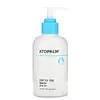What's inside
What's inside
 Key Ingredients
Key Ingredients

 Benefits
Benefits

 Concerns
Concerns

 Ingredients Side-by-side
Ingredients Side-by-side

Water
Skin ConditioningDisodium Cocoyl Glutamate
CleansingDisodium Cocoamphodiacetate
CleansingPropanediol
SolventGlycerin
HumectantSodium Chloride
MaskingCoco-Glucoside
CleansingXanthan Gum
EmulsifyingSodium Sweetalmondamphoacetate
CleansingMyristoyl/Palmitoyl Oxostearamide/Arachamide Mea
Skin ConditioningSimmondsia Chinensis Seed Oil
EmollientHelianthus Annuus Seed Oil
EmollientVitis Vinifera Seed Oil
EmollientCarthamus Tinctorius Seed Oil
MaskingCamellia Sinensis Seed Oil
HumectantCentella Asiatica Extract
CleansingMadecassoside
AntioxidantCocodimonium Hydroxypropyl Hydrolyzed Wheat Protein
CleansingSodium Phytate
Citric Acid
BufferingSodium Citrate
BufferingHexylene Glycol
Emulsifying1,2-Hexanediol
Skin ConditioningCaprylyl Glycol
EmollientArtemisia Vulgaris Oil
PerfumingSantalum Album Oil
MaskingWater, Disodium Cocoyl Glutamate, Disodium Cocoamphodiacetate, Propanediol, Glycerin, Sodium Chloride, Coco-Glucoside, Xanthan Gum, Sodium Sweetalmondamphoacetate, Myristoyl/Palmitoyl Oxostearamide/Arachamide Mea, Simmondsia Chinensis Seed Oil, Helianthus Annuus Seed Oil, Vitis Vinifera Seed Oil, Carthamus Tinctorius Seed Oil, Camellia Sinensis Seed Oil, Centella Asiatica Extract, Madecassoside, Cocodimonium Hydroxypropyl Hydrolyzed Wheat Protein, Sodium Phytate, Citric Acid, Sodium Citrate, Hexylene Glycol, 1,2-Hexanediol, Caprylyl Glycol, Artemisia Vulgaris Oil, Santalum Album Oil
Water
Skin ConditioningSodium Laureth Sulfate
CleansingSodium Chloride
MaskingCocamidopropyl Betaine
CleansingParfum
MaskingSodium Salicylate
PreservativeGlycerin
HumectantSodium Benzoate
MaskingGlycol Distearate
EmollientLauryl Hydroxysultaine
CleansingCitric Acid
BufferingPolyquaternium-7
Coco-Glucoside
CleansingTetrasodium EDTA
PEG-150 Pentaerythrityl Tetrastearate
EmulsifyingPPG-2 Hydroxyethyl Cocamide
EmulsifyingGlyceryl Oleate
EmollientGlyceryl Stearate
EmollientMel
EmollientPrunus Amygdalus Dulcis Fruit Extract
Skin ConditioningCitrus Aurantium Dulcis Peel Oil
MaskingBenzyl Benzoate
AntimicrobialBenzyl Salicylate
PerfumingHexyl Cinnamal
PerfumingCI 16255
Cosmetic ColorantCI 19140
Cosmetic ColorantWater, Sodium Laureth Sulfate, Sodium Chloride, Cocamidopropyl Betaine, Parfum, Sodium Salicylate, Glycerin, Sodium Benzoate, Glycol Distearate, Lauryl Hydroxysultaine, Citric Acid, Polyquaternium-7, Coco-Glucoside, Tetrasodium EDTA, PEG-150 Pentaerythrityl Tetrastearate, PPG-2 Hydroxyethyl Cocamide, Glyceryl Oleate, Glyceryl Stearate, Mel, Prunus Amygdalus Dulcis Fruit Extract, Citrus Aurantium Dulcis Peel Oil, Benzyl Benzoate, Benzyl Salicylate, Hexyl Cinnamal, CI 16255, CI 19140
 Reviews
Reviews

Ingredients Explained
These ingredients are found in both products.
Ingredients higher up in an ingredient list are typically present in a larger amount.
Citric Acid is an alpha hydroxy acid (AHA) naturally found in citrus fruits like oranges, lemons, and limes.
Like other AHAs, citric acid can exfoliate skin by breaking down the bonds that hold dead skin cells together. This helps reveal smoother and brighter skin underneath.
However, this exfoliating effect only happens at high concentrations (20%) which can be hard to find in cosmetic products.
Due to this, citric acid is usually included in small amounts as a pH adjuster. This helps keep products slightly more acidic and compatible with skin's natural pH.
In skincare formulas, citric acid can:
While it can provide some skin benefits, research shows lactic acid and glycolic acid are generally more effective and less irritating exfoliants.
Most citric acid used in skincare today is made by fermenting sugars (usually from molasses). This synthetic version is identical to the natural citrus form but easier to stabilize and use in formulations.
Read more about some other popular AHA's here:
Learn more about Citric AcidCoco-Glucoside is a surfactant, or a cleansing ingredient. It is made from glucose and coconut oil.
Surfactants help gather dirt, oil, and other pollutants from your skin to be rinsed away.
This ingredient is considered gentle and non-comedogenic. However, it may still be irritating for some.
Learn more about Coco-GlucosideGlycerin is already naturally found in your skin. It helps moisturize and protect your skin.
A study from 2016 found glycerin to be more effective as a humectant than AHAs and hyaluronic acid.
As a humectant, it helps the skin stay hydrated by pulling moisture to your skin. The low molecular weight of glycerin allows it to pull moisture into the deeper layers of your skin.
Hydrated skin improves your skin barrier; Your skin barrier helps protect against irritants and bacteria.
Glycerin has also been found to have antimicrobial and antiviral properties. Due to these properties, glycerin is often used in wound and burn treatments.
In cosmetics, glycerin is usually derived from plants such as soybean or palm. However, it can also be sourced from animals, such as tallow or animal fat.
This ingredient is organic, colorless, odorless, and non-toxic.
Glycerin is the name for this ingredient in American English. British English uses Glycerol/Glycerine.
Learn more about GlycerinChances are, you eat sodium chloride every day. Sodium Chloride is also known as table salt.
This ingredient has many purposes in skincare: thickener, emulsifier, and exfoliator.
You'll most likely find this ingredient in cleansers where it is used to create a gel-like texture. As an emulsifier, it also prevents ingredients from separating.
There is much debate on whether this ingredient is comedogenic. The short answer - comedogenic ratings don't tell the whole story. Learn more about comegodenic ratings here.
The concensus about this ingredient causing acne seems to be divided. Research is needed to understand if this ingredient does cause acne.
Scrubs may use salt as the primary exfoliating ingredient.
Learn more about Sodium ChlorideWater. It's the most common cosmetic ingredient of all. You'll usually see it at the top of ingredient lists, meaning that it makes up the largest part of the product.
So why is it so popular? Water most often acts as a solvent - this means that it helps dissolve other ingredients into the formulation.
You'll also recognize water as that liquid we all need to stay alive. If you see this, drink a glass of water. Stay hydrated!
Learn more about Water